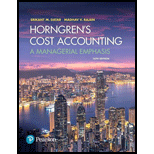
Concept explainers
Budgeting, ethics, pharmaceutical company. Chris Jackson was recently promoted to Controller of Research and Development (R&D) for BrisCor, a Fortune 500 pharmaceutical company that manufactures prescription drugs and nutritional supplements. The company’s total R&D cost for 2017 was expected (budgeted) to be $5 billion. During the company’s midyear budget review, Chris realized that current R&D expenditures were already at $3.5 billion, nearly 40% above the midyear target. At this current rate of expenditure, the R&D division was on track to exceed its total year-end budget by $2 billion!
In a meeting with CFO Ronald Meece later that day, Jackson delivered the bad news. Meece was both shocked and outraged that the R&D spending had gotten out of control. Meece wasn’t any more understanding when Jackson revealed that the excess cost was entirely related to research and development of a new drug, Vyacon, which was expected to go to market next year. The new drug would result in large profits for BrisCor, if the product could be approved by year-end.
Meece had already announced his expectations of third-quarter earnings to Wall Street analysts. If the R&D expenditures weren’t reduced by the end of the third quarter, Meece was certain that the targets he had announced publicly would be missed and the company’s stock price would tumble. Meece instructed Jackson to make up the budget shortfall by the end of the third quarter using “whatever means necessary.”
Jackson was new to the controller’s position and wanted to make sure that Meece’s orders were followed. Jackson came up with the following ideas for making the third-quarter budgeted targets:
- a. Stop all research and development efforts on the drug Vyacon until after year-end. This change would delay the drug going to market by at least 6 months. It is possible that in the meantime a BrisCor competitor could make it to market with a similar drug.
- b. Sell off rights to the drug Martek. The company had not planned on doing this because, under current market conditions, it would get less than fair value. It would, however, result in a one-time gain that could offset the budget shortfall. Of course, all future profits from Martek would be lost.
- c. Capitalize some of the company’s R&D expenditures, reducing R&D expense on the income statement. This transaction would not be in accordance with GAAP, but Jackson thought it was justifiable because the Vyacon drug was going to market early next year. Jackson would argue that capitalizing R&D costs this year and expensing them next year would better match revenues and expenses.
- 1. Referring to the “Standards of Ethical Behavior for Practitioners of
Management Accounting andFinancial Management ,” Figure 1-7 (page 17),which of the preceding items (a–c) are acceptable to use? Which are unacceptable?
Required
- 2. What would you recommend Jackson do?
Want to see the full answer?
Check out a sample textbook solution
Chapter 1 Solutions
Horngren's Cost Accounting: A Managerial Emphasis (16th Edition)
- A factory has direct labor costs of $51,000 and direct material costs of $33,000. If the factorys overhead rate is 166% of direct labor costs, what is the total manufacturing cost?arrow_forwardSolve this question general Accountingarrow_forwardDon't use ai given answer accounting questionsarrow_forward
- Financial accountingarrow_forwardIf a company's net income for the year is $115,000 and its total assets at the beginning of the year were $525,000, while its total assets at the end of the year were $710,000, what is the company's return on assets (ROA)? Help me with this financial accounting Queryarrow_forwardThe green tree company manufacturers woodenarrow_forward
- If a company's net income for the year is $115,000 and its total assets at the beginning of the year were $525,000, while its total assets at the end of the year were $710,000, what is the company's return on assets (ROA)?arrow_forwardKindly help me with accounting questionsarrow_forwardA business purchases a machine for $12,000 and expects it to have a useful life of 5 years with a salvage value of $2,500. What is the annual depreciation expense using the straight-line method?arrow_forward
 EBK CONTEMPORARY FINANCIAL MANAGEMENTFinanceISBN:9781337514835Author:MOYERPublisher:CENGAGE LEARNING - CONSIGNMENT
EBK CONTEMPORARY FINANCIAL MANAGEMENTFinanceISBN:9781337514835Author:MOYERPublisher:CENGAGE LEARNING - CONSIGNMENT Cornerstones of Cost Management (Cornerstones Ser...AccountingISBN:9781305970663Author:Don R. Hansen, Maryanne M. MowenPublisher:Cengage Learning
Cornerstones of Cost Management (Cornerstones Ser...AccountingISBN:9781305970663Author:Don R. Hansen, Maryanne M. MowenPublisher:Cengage Learning

